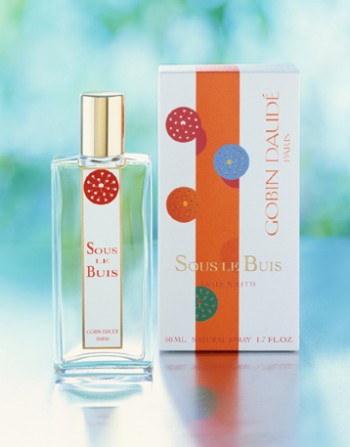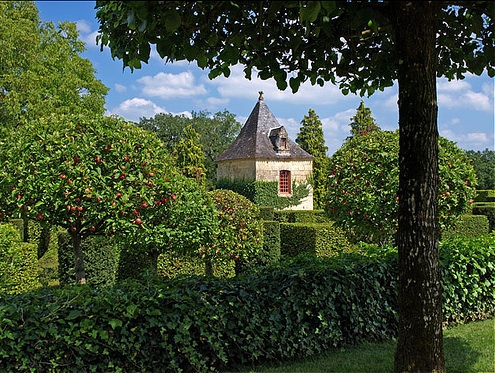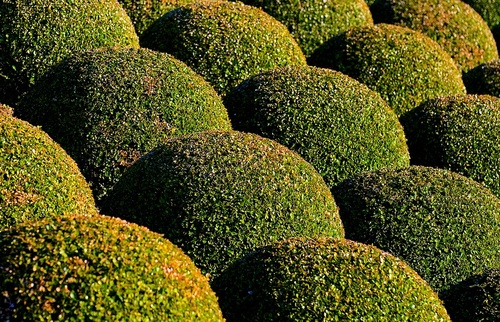Parfums Gobin-Daude Sous Le Buis (2002): Green Leafy Animality {Perfume Review & Musings} {Fresh Notebook}


The Eyrignac garden in Périgord by cytonick
As far as I can tell the perfume brand Parfums Gobin-Daudé founded by perfumer Victoire Gobin-Daudé was commercialized ca. 2001 and during its short life-span managed to garner the kind of favorable rumoring that ought to equate its career with enduring success. In this case however a discrepancy became apparent as the buzz lived on while the brand went down ca. 2003, whether for marketing or personal reasons mainly, or both, I am not clear about this. But still today whenever a Gobin-Daudé bottle is dug up from oblivion, a little feverishness ensues.

Topiary in Château d'Amboise by Baloulumix
Sous Le Buis (Under the Boxwood) is on one level a delightfully fresh, scrupulously rendered yet poetic take on the addictive, for me, smell of boxwood. For anyone who thinks that a fraction of paradise can be had by burying one's nose in the scratchy leafage of a round-shaped boxwood sculptured like a stone architectural element salvaged from an old castle, Sous Le Buis allows you to prolong that sensation beyond that short-lived rapturous moment experienced during a walk. The scent of boxwood, like that of violets, also seems a bit elusive when you stay too long with it although it characteristically permeates the air in French public gardens.
On another level, Sous Le Buis is like an excerpt from a roman à clés rich with symbolism with a little touch of enchantment borrowed from an atmosphere comparable to that of the film La Belle et La Bête (Beauty and the Beast) by Jean Cocteau. It is intriguing, not easy to decipher at first with its strange co-mingling of green and animalistic overtones which later on make sense in reference to the sexed history of boxwood...
Finally, the lesson one can retain from Sous Le Buis is that here is a kind of freshness, a slightly overlooked one perhaps at play: the green, leafy kind that can make do - one might have nearly forgotten it because it is so obvious - without the sea air, the salty breeze and the transparency of water. That other take on freshness that was embodied most typically perhaps with Vent Vert (galbanum) by Balmain has been neglected somewhat in the recent period by compositions that have turned their attention to different sources of inspiration for delivering the sense of freshness in a perfume: citruses in vivacious eaux de Cologne, drippy juicy summer fruits, marine scents, aquatic perfumes. The new Géranium pour Monsieur by Editions de Parfums however, one can note, is leaving air and water behind for a leafy sensation of coolness as one of its aims; Le Temps D'une Fête by Patricia de Nicolaï was also very green (lentisc, galabanum, hyacinths). Byredo produced Green last year and Miller & Bertaux have dedicated an ode to that kind of sappy freshness with the unequivocally named Green, Green, Green and Green.
Boxwood being so linked with children's memories of playing in gardens, it holds further a subliminal baudelairean reference to that idea of green freshness encapsulated in the verses "II est des parfums frais comme des chairs d'enfant, Doux comme les hautbois,
verts comme les prairies." (There are perfumes fresh like children's flesh, soft like oboes, green like meadows.)
Sous Le Buis seems to have three main tonalities to it: the expected green and crisp one, a discreetly balmy-coumarine-y-powdery one, à la Shalimar, and an animalic one. Gobin-Daudé has said in the past that she feels a strong bond with nature and this can readily be felt in the perfume. She also added that she never neglects to use ingredients that recall the animalistic and instinctive side of us all.
Sous Le Buis allows us to put together these two separate statements: it is a scent both strongly based on natural observation and infused with an almost fantasmagoric animalic presence, this being more surprising in the context of a green scent. One is reminded then that the ancient Romans would use boxwood in their art of topiary to carve wild beasts in order to tame both animals and plants and affirm cultural order over nature. The fact that boxwood has an animalic essence to it makes this art even more meaningful on the symbolic level. Regarding that animalistic facet, one can notice that boxwood has a more or less sweaty, even piss-y olfactory nuance to put it in a down to earth manner, especially when a little dry, that may confuse the stroller in a garden into thinking that around the corner stands a latrine heaving in the summer. If there turns out to be a real latrine then the smell of boxwood will make you think that it acts as a natural and clever deodorizer known by landscape artists for generations (yes, just imagine the gardens at Versailles in realistic mode in the 18th century) thanks to the ambiguous proximity of both scents on the scale of muskiness.
Thinking of the name of one of her other fragrances, Biche dans l'Absinthe (Doe in Absinth), I am tempted to think of Sous Le Buis as being about a doe hiding shyly under the Boxwood for the unusual and paradoxical impression of pristine green foresty animality it suggests. Through an illusory play with the senses, a rare sensation emerges, that of a virginal, clean and green sensation of animality. These effects cohabit without any problems.
Boxwood has also been associated with sexuality in both history and literature. To call upon only two examples, Albert le Grand once declared that the smell of human sperm indicating fertility could be detected as it approximated that of boxwood. The writer Colette who had one of the keenest noses in literature talked about the scent of a woman who is sexually aroused as one akin to the smell of boxwood in the heat and that of a man during lovemaking as comparable to the diffusion of the perfume of a rubbed piece of boxwood.
The fact that Parfums Gobin-Daudé no longer exist - although there was a rumor at one point that she was preparing to make a come-back -undeniably adds to the mystique of a moment unique in time.
The perfume on its own is a little bit enchanted and remarkably pure and linear. It smells of boxwood from start to finish except that it literally shape-shift into a forest creature. You feel like you are walking by a bucolic box hedge all the while that you are wearing the perfume. The diffusion is impeccable although the scent does not last very long, maybe 2 or 3 hours, due to the use of natural raw materials. If it came back it would be a perfect candidate for a discreet and dedicated cult following.
Notes: galbanum, lavender, sage, clary, orange flower










I just absolutely adore your blog Marie-Helene, I think it is hands down the best perfume blog out there...Victoire Gobin-Daude brought me out of depression in part with her range, and I am forever thankful to her in that moment in time. Truly inspired work, her and your words!
I have a small question: could you help me identify what exactly smells of boxwood in this perfume? is it clary sage or so? I have The New Perfume Handbook by Nigel Groom and cannot find boxwood or buxus or buis as a listed note...
Thank you forever,
:) Sands
Sands,
Thank you very much for your kind words.
I believe that there is no essential oil of boxwood (to be verified) although boxwood has been used in perfumery since the Antiquity. I see references to fat or olive oil infusions of boxwood leaves in both the Antiquity and in the 19th century. In the the 19th century boxwood flowers were also a material used in perfumery.
I myself am familiar with the scent of the plant, i.e. leaves + wood, but I believe I have never had the opportunity to smell a blossoming boxwood.
The plant contains essential oils, but they are toxic so are used in moderation only for medicinal purposes, usually as infusions.
My impression was that Gobin-Daudé had recreated in a poetico-realistic manner the diffusive scent of boxwood as you would smell it in a garden. There are well-known musky, urine-y nuances to it as well as fresh vegetable ones. I wish I had a boxwood at hand to sniff now. Clary sage can be quite multi-faceted so it might contribute to the accord, but one would need to study your question more closely.
It's a great question anyway and an excellent exercise to try to analytically decompose the scent of boxwood into its principal facets.